Slot machines: where did they come from in the USSR and how are they arranged
On November 30, RUVDS, together with the Museum of Soviet Gaming Machines, will hold the first Game Overnight old-school video game tournament in Russia. Now there is a qualifying tournament, for 3 days already more than 300 habrizhiteley participated in the tournament. Few were able to take the test. You can try your hand at the game site . In the meantime, we decided to recall how the first automata appeared in the USSR, tell us a little about their device and help players practice before the tournament.
Slot machines appeared in the USSR much later than in the rest of the world. When in America and Japan they were already playing pinball and arcade shooters, the Soviet people were just beginning to get acquainted with carousels, roller coasters and slot machines.

In the summer of 1971, in the Gorky Park and in the Izmailovsky Park in Moscow, a large international exhibition "Attraction-71" was held, to which foreign manufacturers brought 180 most different slot machines. Most of the Soviet residents haven’t seen anything like this before, and even more so - they haven’t played anything, so it’s not surprising that 2.5 million people visited the exhibition in 10 days!
Exhibition "Attraction-71":
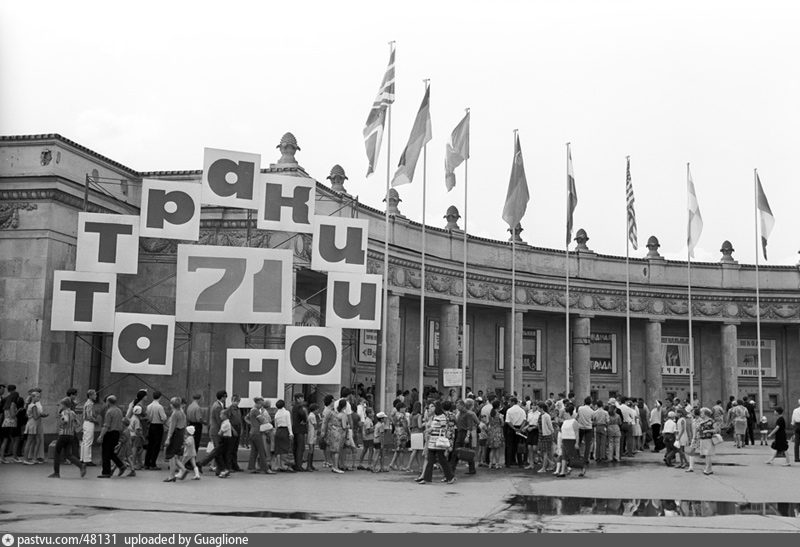
For everyone, including the All-Union Union "Soyuzattraktsion", the departments that organized the exhibition, the enormous interest in slot machines and their future potential became apparent. But instead of concluding contracts with manufacturing companies or buying out a license for the production of similar arcades in the USSR, Soyuzattraktsion acted differently: out of almost two hundred foreign “exhibition” machines, 30 of the most popular were selected and sent to Soviet factories, where Western prototypes were disassembled, carefully studied, and Soviet arcades were produced on their basis.
The factories where Soviet specialists analyzed and studied Western automatons were military. In most of the time, most of these factories produced components and sophisticated electronics for the defense industry. It was no coincidence that automata appeared at military enterprises: no one began to build separate factories for “frivolous” devices, and military factories had sufficient resources and personnel for the production of automata. In addition, every enterprise in the USSR, regardless of what was produced on it, had a financial plan for the release of “consumer goods” goods, one of the types of which were gaming machines.
However, the Soviet planned model of the economy made adjustments to the issues of production: indeed, Soviet engineers dismantled Western automata and, on their basis, made Soviet ones, but only from the components available at a particular plant. The “planned” set of parts that each Soviet factory received was not always suitable for creating one or another machine gun, so I had to work with what was before. Because of this, engineers had to assemble complex designs that could be easily simplified (and cheaper!) If they had the right parts.
In all, from the early 1970s to the early 1990s, about a hundred varieties of slot machines were released in the USSR. 95% of them were copies of Western automata, the rest were original Soviet developments, some machines were produced for decades, gradually modernizing and improving, others were removed from production due to unpopularity, lack of payback or production difficulties.
All gaming machines can be classified using different division principles. The easiest way - distribution by topic. So, the Soviet arcades can be divided into military, sports, shooting and racing simulators, pinballs, automatic rockers. A more accurate and complex classification is technical, according to which all Soviet gaming machines are divided into electromechanical and electronic. The latter are based on discrete logic, and to display the playing field in them, as a rule, a television screen is used.
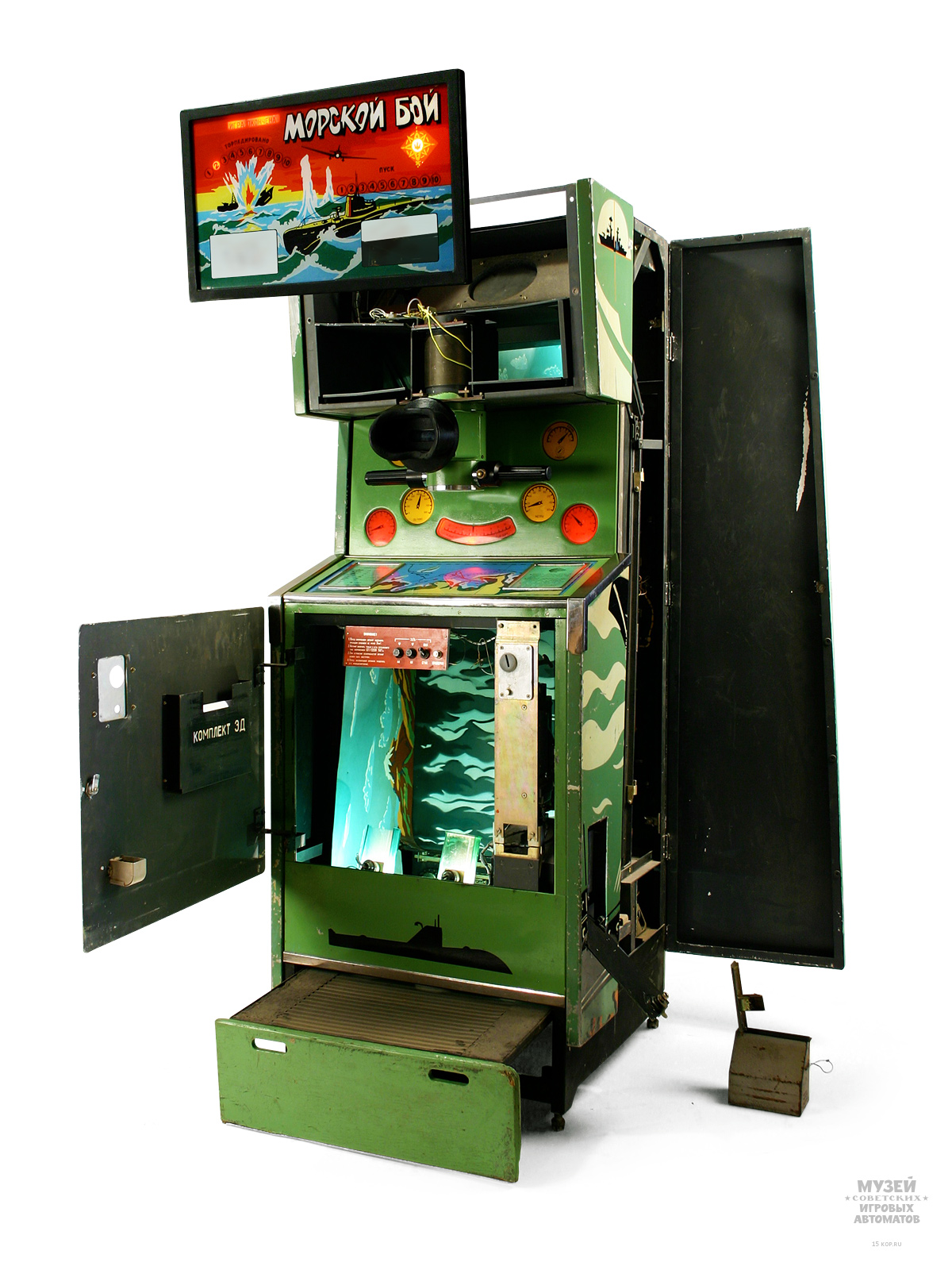
The legendary Soviet slot machine - “Sea Battle” - is an electromechanical arcade. The purpose and principle of the game are well known to many who were born even in the late Soviet Union: take aim at the periscope (by the way, made in the likeness of the real ones) at ships on the horizon and “torpedo” - shoot at them, releasing torpedoes.
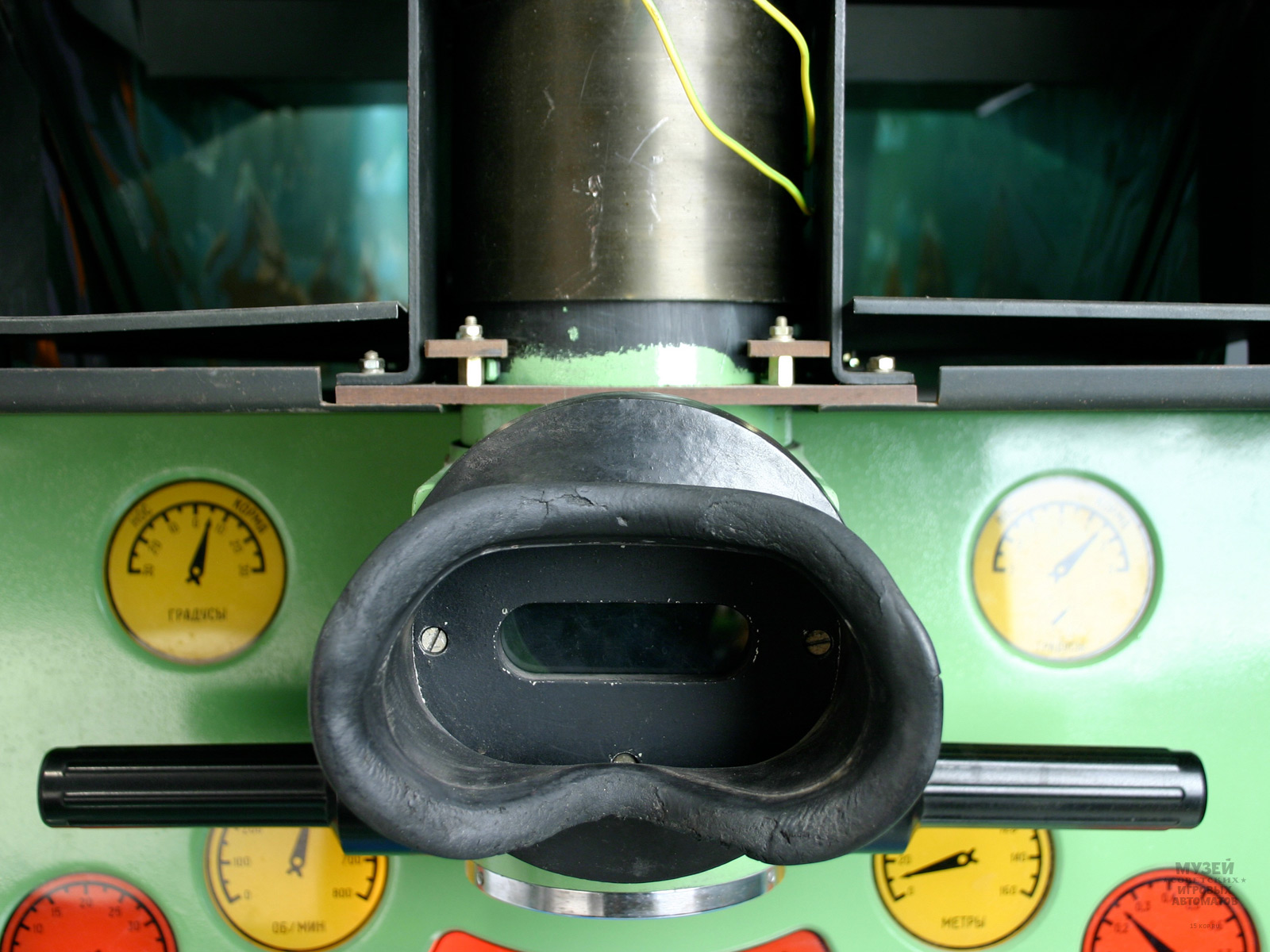
Viewfinder
The player has 10 torpedoes at his disposal, and in the event that all 10 shots reach the goal, the player will receive a reward - 3 additional torpedoes.
The Soviet "Sea Battle" was copied from the American Sea Rider and Sea Devil machines, produced by Chicago-based Midway since 1969. American manufacturers realized that the linear arrangement of the game elements greatly influenced the dimensions of the arcade, making it impermissibly cumbersome, therefore the principle of mirror reflection lies at the heart of the arrangement of the internal components.
The panorama of “combat” actions, that is, the playing field itself, is positioned vertically, but being reflected in a mirror set at an angle of 45 °, looks horizontal. The imitation of the sea is made of glass, on which a picture of the sea is applied, and under the glass are the torpedo movement trajectories - 8 “tracks”, each with 10 light bulbs.

Top view of the mechanism for selecting the trajectory of the torpedo. On the left, there are 8 contacts responsible for the tracks.
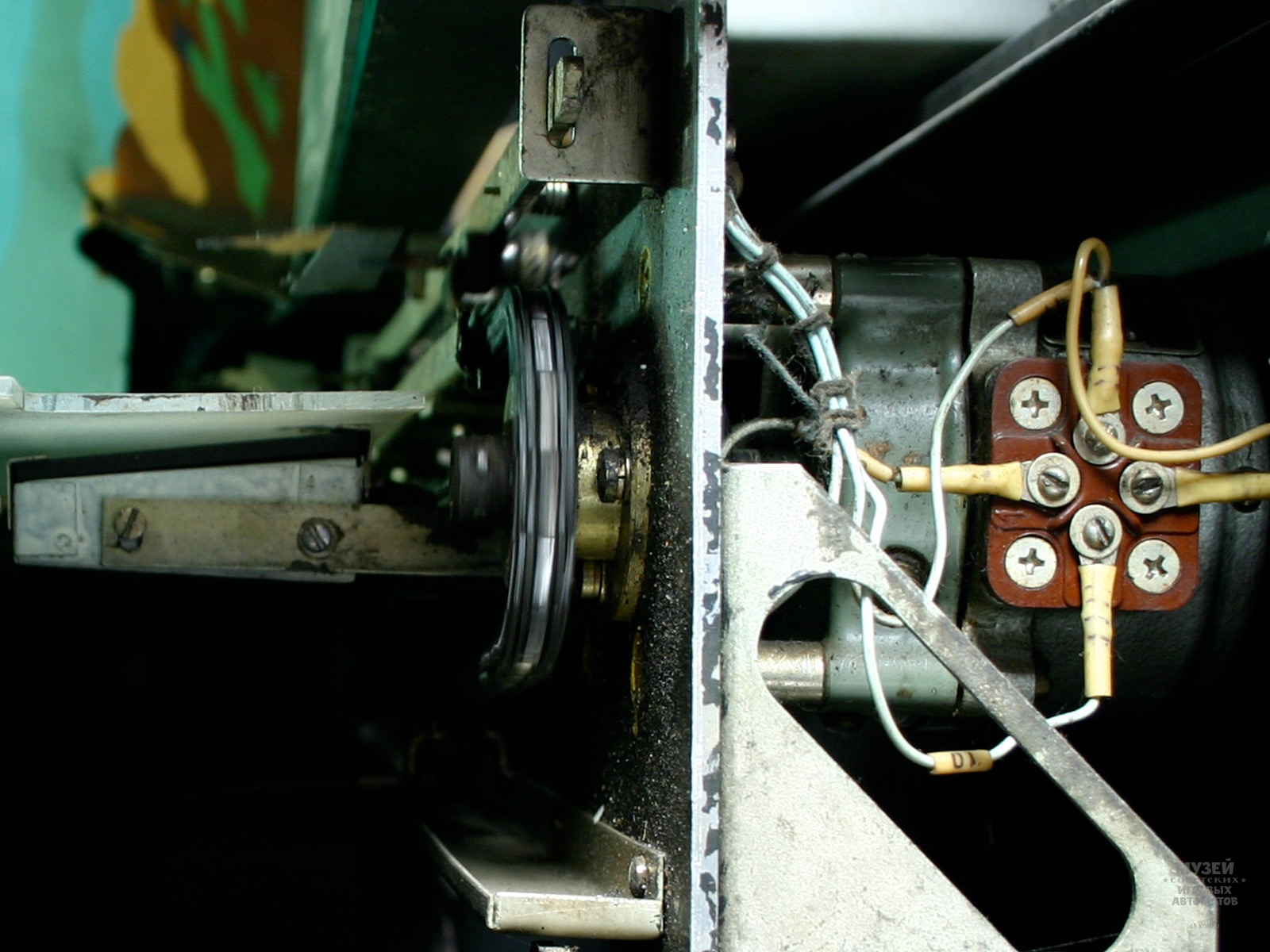
The mechanism that drives the ships. Located at the bottom of the machine. On the left you can see the chain on which the figures are fixed.
Launching a torpedo, the player actually closes one of the 8 contacts of the torpedo's flight path selection mechanism, light bulbs in the selected “track” light up one after the other, creating the illusion of a dynamically flying torpedo. When the last light bulb coincides with the sensor on the ship, the biggest explosion light turns on, the circuit closes, the player gets a point. Such a principle of fixing the torpedo route makes the device technically more reliable, and, at the same time, the launch of a torpedo becomes less predictable for the player.
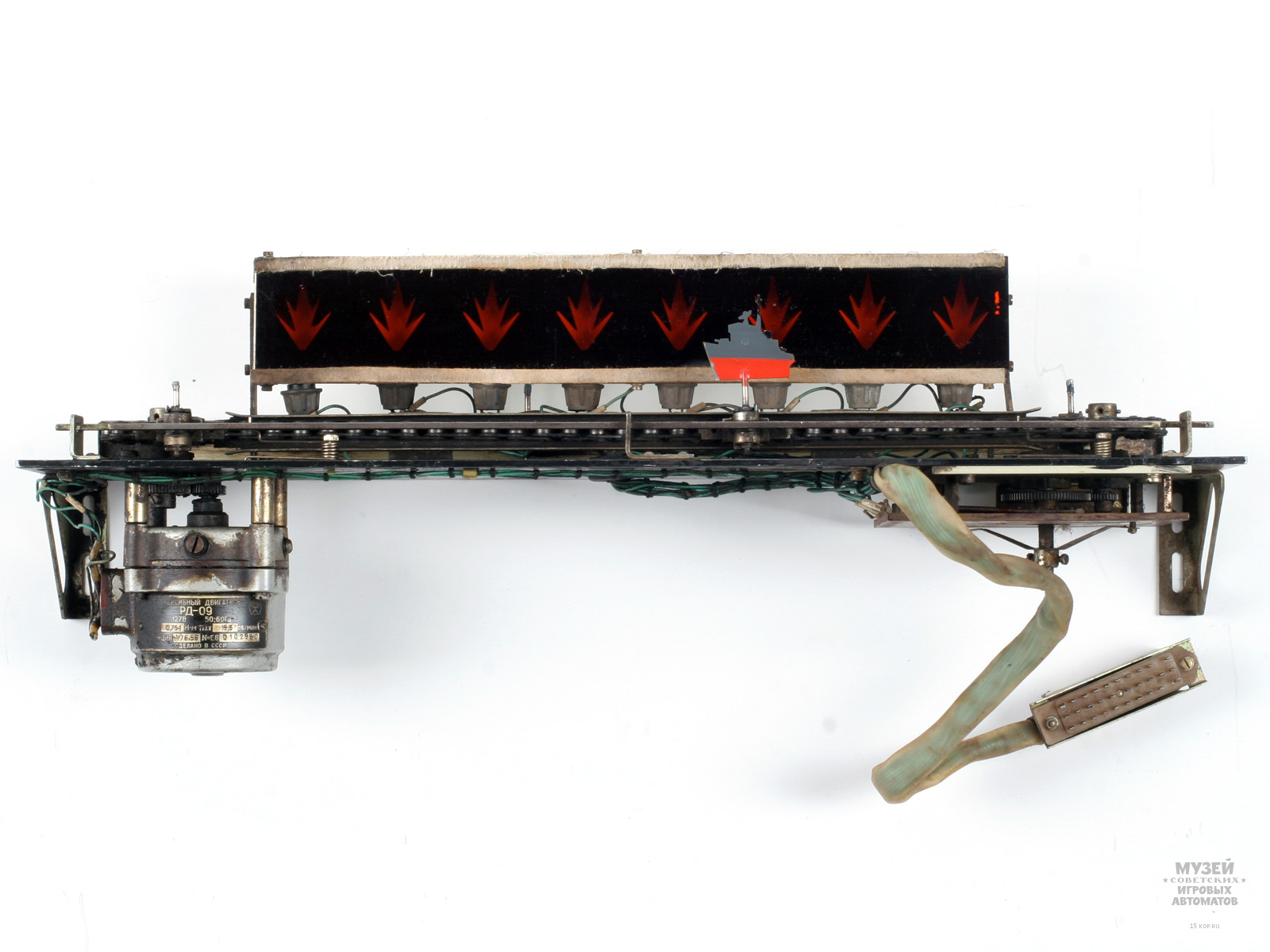
Drive with engine and scoreboard explosions assembly.
The ships that are being fired are flat iron figures attached to a conventional chain (this one is also used in bicycles), which moves along a circular axis. After a torpedo hit, the light in the machine turns off, signaling the player about success, the ships stop and then start moving in the other direction.
→ Play Sea Battleship
"Sea battle" was produced at the Serpukhov radio engineering plant "Ratep" since 1974. The main products of the enterprise in Soviet times were radar control systems for anti-aircraft missile and artillery systems, and modules for controlling the firing of shipborne interference systems. Interestingly, the other machines, produced here, - "Pilot" and "Puck! Washer! ”Arranged according to a similar principle - using mirror reflection.

In total, the plant produced several versions of the “Sea Battle”: for the domestic market and export to the socialist countries and to Finland. One of the versions of the machine was designed specifically for training crews of submarines of the Navy of the USSR. Such machines did not have a coin acceptor, and the inscription “Sea Battle” was replaced with the abbreviation “ET-10M”. The mysterious abbreviation is simply decoded: ET - electronic simulator, 10 - the number of shots, M - modernized. This version of the “Sea Battle” was installed only on nuclear submarines - there was enough space for them - to entertain sailors on long hikes.
"Towns"
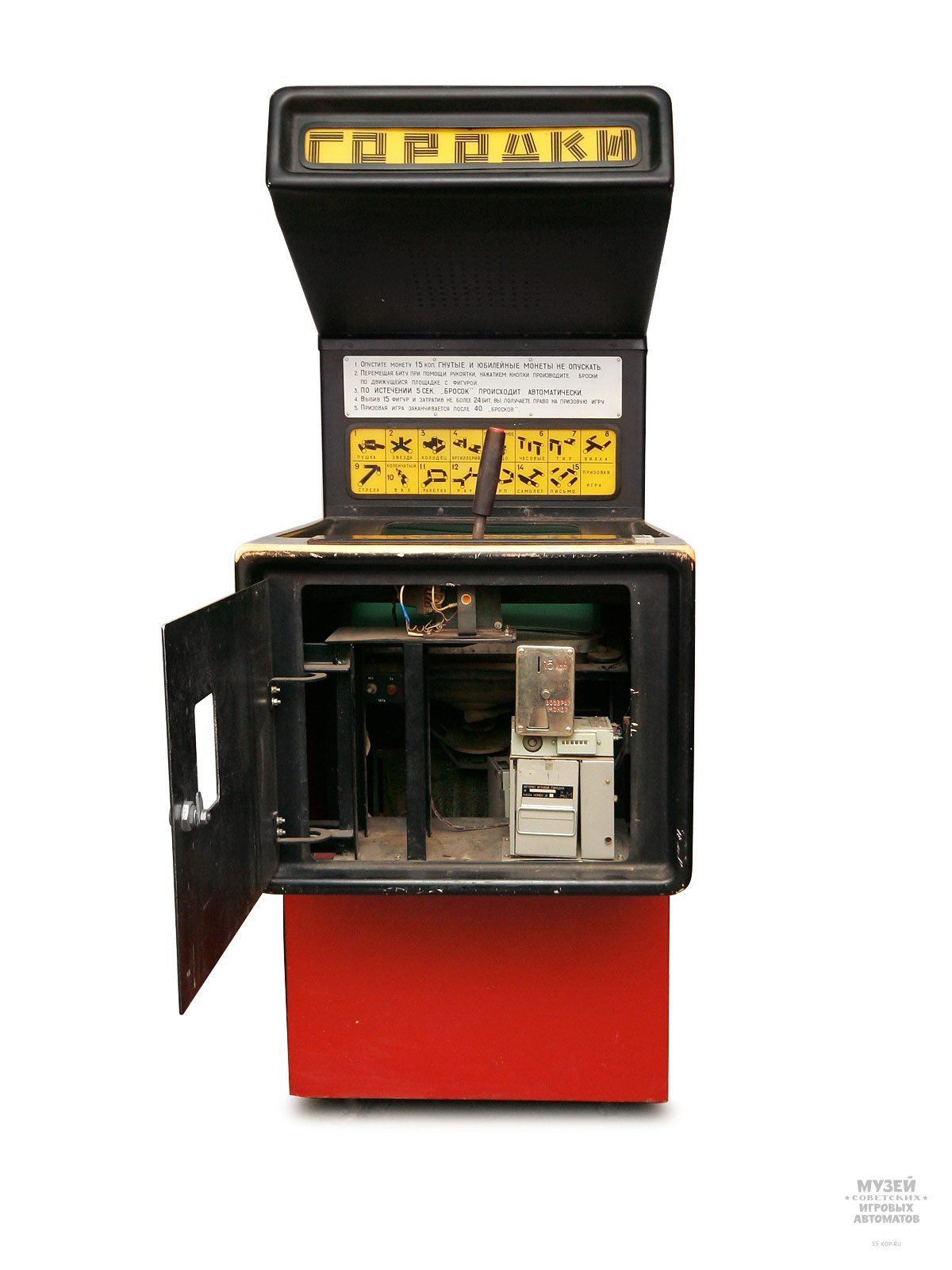
The front panel of the machine is open: a coin-receiving mechanism with a drive is clearly visible.
Electronic gaming machines for the most part are original designs in which borrowed Western ideas are implemented on a Soviet technical base. But there are also completely original Soviet designs, the most famous of which is the Gorodki slot machine.
The gameplay of “Gorodok” was created on the basis of the old Russian game of the same name, which in the course of the 20th century quickly turned from popular fun into a mass sport with its own rules, tournaments and associations. In the 1960s, the towns were the second most popular sport after football, so it is not surprising that, following the actual sports activity, its “arcade” version was created.
The arcades were developed by employees of the Central Research Laboratory of Attraction Techniques (CNILAT), a division of Soyuzattraction, engaged in scientific research and sociological research. The player is given the same task as in a real sport: knock out the city pieces with the least amount of bits.
The set and order of the appearance of figures on the screen also coincides with the rules of the classic sport: from the simplest “cannon”, to the most complex - the “letter”.
On the kinescope of the automaton, the view of the game is presented from above, therefore everything that is displayed on the screen - bits and figures - is translated into a two-dimensional pixel format. To make the game more interesting and more difficult, the figures move, and the bit flies out automatically after 5 seconds.
The Gorodki submachine gun was manufactured at the Terminal plant located in the Ukrainian city of Vinnitsa. In Soviet times, the company was a "monopolist" in the production of displays and screens, including for the defense industry. The plant also produced consumer goods, including slot machines. It was profitable for industrialists to use displays in their products, therefore, among the gaming machines for production, we chose those in which kinescopes were used to display the image. So, together with “Gorodok”, “Terminal” produced “Motor Racing”, “Fighters” and all the automata based on the TIA-МЦ-1 platform.
TIA-MTs-1

Multi-color color television slot machine, better known as TIA-MTs-1, is a type of Soviet electronic slot machines with interchangeable game programs. In the Soviet Union, all TIA-МЦ-1 automata were produced in identical cases, which differed only in color, the content of the game instruction and the designations of the controls.
On the basis of the TIA-MTs-1 platform, 12 original games were created: “The Little Humpbacked Horse”, “The Snow Queen”, “SOS”, “Fisherman Cat”, “Star Knight”, “Fighter”, “Kotigoroshko”, “The Island dragon "," Treasure Island "," Auto Racing "," Billiards "," Towns ". All games for TIA-MTs-1 were developed by Extrema-Ukraine in the mid-1980s, and the machines themselves were produced at the Terminal production association.
Structurally, the machine consists of a monitor with a 16-color screen and a resolution of 256x256 pixels, a control console and a base, in which the gaming machine element blocks (BEIA) are located, made in the form of separate boards.
The block BIA-100 is designed to process logical information in accordance with the game program; convert a digital code to analog signals of the color R, G, B; the formation of sound signals, control of the coin acceptor and communication with the remote control. BIA-101 is designed to form synchronization series and background image elements. BIA-102 forms moving objects of the image, and BIA-103 is needed to store the game program, background pictures, moving objects and other operational information. Actually, in order to change the gaming gaming program in the machine, it was necessary to replace the BIA-103 unit.
At the Game Overnight tournament, participants will have to fight each other not only in cult video games, but also in no less legendary Soviet racing arcades - “Highway” and “AutoRally”. To be at the tournament fully armed, we offer to prepare in advance and learn all the subtleties of the gameplay of Soviet arcade races.
"Highway"
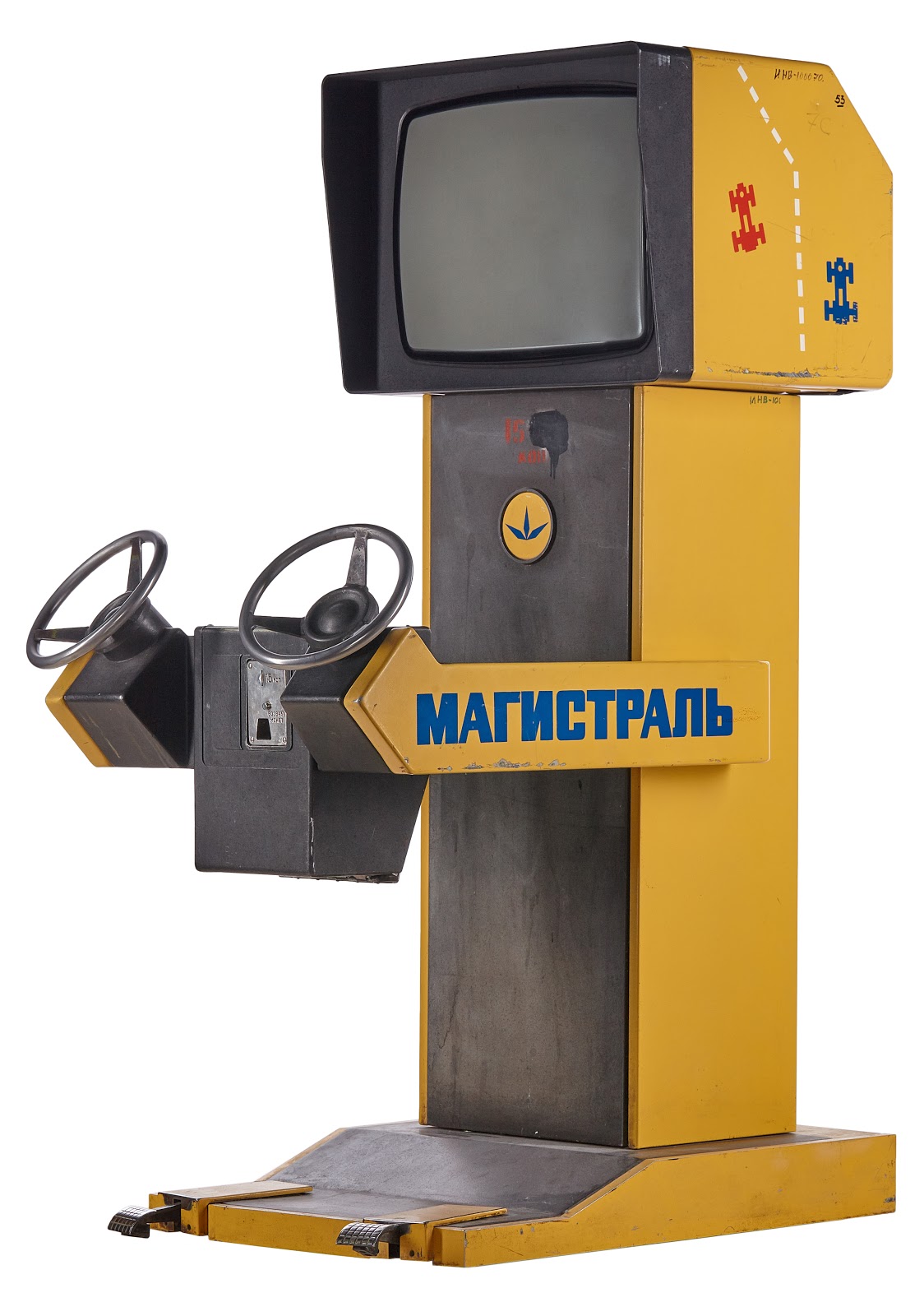
"Highway" - an electronic racing arcade, which in the battle for popularity can easily compete with the "Sea battle" or "Sniper". The machine simulates car races on different track variants, the course of the game is displayed on the TV screen, and you can play the “Highway” alone or together, driving your car using the steering wheel and the gas pedal.
Players can choose one of the options of the route:
The “training track” mode is the easiest option of racing, in which oncoming cars are static
“Racing” mode - a track with an opposite lane, where virtual opponents drive different cars - both standard and supercars in two times wider than the "norm".
"Special" track- This is a race with passing static cars with a special vehicle. The player must maneuver, passing other cars forward or overtaking them. The game is complicated by occasionally passing special vehicles, whose speed is significantly higher than the total flow.
"Night" mode simulates artificial lighting from car headlights. In complete darkness of the "night" mode, you need to remember that at the same time on the lane there can be two cars moving in the opposite lane.
The icy mode is a race with passing dynamic machines in which virtual rivals slide in the same direction as the player. At the same time on the screen can be displayed three race cars of "rivals".
→ Choose a track, practice and play “Highway” here
And in the “Highway” slot machine, the route is selected by using touch (!) Devices on the machine panel!
"Rally"
Avtoralli-M is another Soviet racing arcade for one or two players. The control principle is typical for many racing cars - at the disposal of the player the steering wheel and the gas pedal, the process of the game, as well as in the "Highway", is displayed on the TV screen located horizontally, but the game situation is different.
The goal of a player in Avtoralli is not to overtake an opponent, but to collect as many points as possible, which are “scattered” across the board in the form of green flags. To win in AutoRally, players need to run into them, collecting points. But blue oil stains, red flags and white barriers should be avoided: when a player hits them, the player loses control and speed. A few seconds before the end of the game, the glasses begin to flash: at this moment it is better to concentrate and hurry, because the number of points on the touched flag doubles.
The Avtoralli-M machine gun (the letter “M”, as in many other Soviet arcades, means “modernized”) was produced at the Komtur production association in Tomsk. In Soviet times, the company mainly produced numerical control devices and electronic stuffing for rockets.
→ Play AutoRally
Dear Readers! We invite you to take part in the first in Russia tournament on the old school video game Game Overnight . The tournament has a qualifying part and the real battle of the best of the best, which will take place on November 30 at the Museum of Soviet Gaming Machines. We are waiting for the tournament from 20 to 3 pm, foamy drinks Smart Admin, Dj Cucumber (Sergey Mezentsev), and RUVDS admin DJ Unpushible will help him, and we will also try new Sub Zero snow burgers from our admins. So, as they say, welcome!

Slot machines appeared in the USSR much later than in the rest of the world. When in America and Japan they were already playing pinball and arcade shooters, the Soviet people were just beginning to get acquainted with carousels, roller coasters and slot machines.

In the summer of 1971, in the Gorky Park and in the Izmailovsky Park in Moscow, a large international exhibition "Attraction-71" was held, to which foreign manufacturers brought 180 most different slot machines. Most of the Soviet residents haven’t seen anything like this before, and even more so - they haven’t played anything, so it’s not surprising that 2.5 million people visited the exhibition in 10 days!
Exhibition "Attraction-71":

For everyone, including the All-Union Union "Soyuzattraktsion", the departments that organized the exhibition, the enormous interest in slot machines and their future potential became apparent. But instead of concluding contracts with manufacturing companies or buying out a license for the production of similar arcades in the USSR, Soyuzattraktsion acted differently: out of almost two hundred foreign “exhibition” machines, 30 of the most popular were selected and sent to Soviet factories, where Western prototypes were disassembled, carefully studied, and Soviet arcades were produced on their basis.
Production: military factories and consumer goods
The factories where Soviet specialists analyzed and studied Western automatons were military. In most of the time, most of these factories produced components and sophisticated electronics for the defense industry. It was no coincidence that automata appeared at military enterprises: no one began to build separate factories for “frivolous” devices, and military factories had sufficient resources and personnel for the production of automata. In addition, every enterprise in the USSR, regardless of what was produced on it, had a financial plan for the release of “consumer goods” goods, one of the types of which were gaming machines.
However, the Soviet planned model of the economy made adjustments to the issues of production: indeed, Soviet engineers dismantled Western automata and, on their basis, made Soviet ones, but only from the components available at a particular plant. The “planned” set of parts that each Soviet factory received was not always suitable for creating one or another machine gun, so I had to work with what was before. Because of this, engineers had to assemble complex designs that could be easily simplified (and cheaper!) If they had the right parts.
Slot machines: classification
In all, from the early 1970s to the early 1990s, about a hundred varieties of slot machines were released in the USSR. 95% of them were copies of Western automata, the rest were original Soviet developments, some machines were produced for decades, gradually modernizing and improving, others were removed from production due to unpopularity, lack of payback or production difficulties.
All gaming machines can be classified using different division principles. The easiest way - distribution by topic. So, the Soviet arcades can be divided into military, sports, shooting and racing simulators, pinballs, automatic rockers. A more accurate and complex classification is technical, according to which all Soviet gaming machines are divided into electromechanical and electronic. The latter are based on discrete logic, and to display the playing field in them, as a rule, a television screen is used.
Electromechanics: "Battleship"

The legendary Soviet slot machine - “Sea Battle” - is an electromechanical arcade. The purpose and principle of the game are well known to many who were born even in the late Soviet Union: take aim at the periscope (by the way, made in the likeness of the real ones) at ships on the horizon and “torpedo” - shoot at them, releasing torpedoes.

Viewfinder
The player has 10 torpedoes at his disposal, and in the event that all 10 shots reach the goal, the player will receive a reward - 3 additional torpedoes.
The Soviet "Sea Battle" was copied from the American Sea Rider and Sea Devil machines, produced by Chicago-based Midway since 1969. American manufacturers realized that the linear arrangement of the game elements greatly influenced the dimensions of the arcade, making it impermissibly cumbersome, therefore the principle of mirror reflection lies at the heart of the arrangement of the internal components.
The panorama of “combat” actions, that is, the playing field itself, is positioned vertically, but being reflected in a mirror set at an angle of 45 °, looks horizontal. The imitation of the sea is made of glass, on which a picture of the sea is applied, and under the glass are the torpedo movement trajectories - 8 “tracks”, each with 10 light bulbs.

Top view of the mechanism for selecting the trajectory of the torpedo. On the left, there are 8 contacts responsible for the tracks.

The mechanism that drives the ships. Located at the bottom of the machine. On the left you can see the chain on which the figures are fixed.
Launching a torpedo, the player actually closes one of the 8 contacts of the torpedo's flight path selection mechanism, light bulbs in the selected “track” light up one after the other, creating the illusion of a dynamically flying torpedo. When the last light bulb coincides with the sensor on the ship, the biggest explosion light turns on, the circuit closes, the player gets a point. Such a principle of fixing the torpedo route makes the device technically more reliable, and, at the same time, the launch of a torpedo becomes less predictable for the player.

Drive with engine and scoreboard explosions assembly.
The ships that are being fired are flat iron figures attached to a conventional chain (this one is also used in bicycles), which moves along a circular axis. After a torpedo hit, the light in the machine turns off, signaling the player about success, the ships stop and then start moving in the other direction.
→ Play Sea Battleship
"Sea battle" was produced at the Serpukhov radio engineering plant "Ratep" since 1974. The main products of the enterprise in Soviet times were radar control systems for anti-aircraft missile and artillery systems, and modules for controlling the firing of shipborne interference systems. Interestingly, the other machines, produced here, - "Pilot" and "Puck! Washer! ”Arranged according to a similar principle - using mirror reflection.

In total, the plant produced several versions of the “Sea Battle”: for the domestic market and export to the socialist countries and to Finland. One of the versions of the machine was designed specifically for training crews of submarines of the Navy of the USSR. Such machines did not have a coin acceptor, and the inscription “Sea Battle” was replaced with the abbreviation “ET-10M”. The mysterious abbreviation is simply decoded: ET - electronic simulator, 10 - the number of shots, M - modernized. This version of the “Sea Battle” was installed only on nuclear submarines - there was enough space for them - to entertain sailors on long hikes.
Electronic arcade
"Towns"

The front panel of the machine is open: a coin-receiving mechanism with a drive is clearly visible.
Electronic gaming machines for the most part are original designs in which borrowed Western ideas are implemented on a Soviet technical base. But there are also completely original Soviet designs, the most famous of which is the Gorodki slot machine.
The gameplay of “Gorodok” was created on the basis of the old Russian game of the same name, which in the course of the 20th century quickly turned from popular fun into a mass sport with its own rules, tournaments and associations. In the 1960s, the towns were the second most popular sport after football, so it is not surprising that, following the actual sports activity, its “arcade” version was created.
The arcades were developed by employees of the Central Research Laboratory of Attraction Techniques (CNILAT), a division of Soyuzattraction, engaged in scientific research and sociological research. The player is given the same task as in a real sport: knock out the city pieces with the least amount of bits.
The set and order of the appearance of figures on the screen also coincides with the rules of the classic sport: from the simplest “cannon”, to the most complex - the “letter”.
On the kinescope of the automaton, the view of the game is presented from above, therefore everything that is displayed on the screen - bits and figures - is translated into a two-dimensional pixel format. To make the game more interesting and more difficult, the figures move, and the bit flies out automatically after 5 seconds.
The Gorodki submachine gun was manufactured at the Terminal plant located in the Ukrainian city of Vinnitsa. In Soviet times, the company was a "monopolist" in the production of displays and screens, including for the defense industry. The plant also produced consumer goods, including slot machines. It was profitable for industrialists to use displays in their products, therefore, among the gaming machines for production, we chose those in which kinescopes were used to display the image. So, together with “Gorodok”, “Terminal” produced “Motor Racing”, “Fighters” and all the automata based on the TIA-МЦ-1 platform.
TIA-MTs-1

Multi-color color television slot machine, better known as TIA-MTs-1, is a type of Soviet electronic slot machines with interchangeable game programs. In the Soviet Union, all TIA-МЦ-1 automata were produced in identical cases, which differed only in color, the content of the game instruction and the designations of the controls.
On the basis of the TIA-MTs-1 platform, 12 original games were created: “The Little Humpbacked Horse”, “The Snow Queen”, “SOS”, “Fisherman Cat”, “Star Knight”, “Fighter”, “Kotigoroshko”, “The Island dragon "," Treasure Island "," Auto Racing "," Billiards "," Towns ". All games for TIA-MTs-1 were developed by Extrema-Ukraine in the mid-1980s, and the machines themselves were produced at the Terminal production association.
Structurally, the machine consists of a monitor with a 16-color screen and a resolution of 256x256 pixels, a control console and a base, in which the gaming machine element blocks (BEIA) are located, made in the form of separate boards.
The block BIA-100 is designed to process logical information in accordance with the game program; convert a digital code to analog signals of the color R, G, B; the formation of sound signals, control of the coin acceptor and communication with the remote control. BIA-101 is designed to form synchronization series and background image elements. BIA-102 forms moving objects of the image, and BIA-103 is needed to store the game program, background pictures, moving objects and other operational information. Actually, in order to change the gaming gaming program in the machine, it was necessary to replace the BIA-103 unit.
Racing machines of the tournament: "Highway" and "AutoRally"
At the Game Overnight tournament, participants will have to fight each other not only in cult video games, but also in no less legendary Soviet racing arcades - “Highway” and “AutoRally”. To be at the tournament fully armed, we offer to prepare in advance and learn all the subtleties of the gameplay of Soviet arcade races.
"Highway"

"Highway" - an electronic racing arcade, which in the battle for popularity can easily compete with the "Sea battle" or "Sniper". The machine simulates car races on different track variants, the course of the game is displayed on the TV screen, and you can play the “Highway” alone or together, driving your car using the steering wheel and the gas pedal.
Players can choose one of the options of the route:
The “training track” mode is the easiest option of racing, in which oncoming cars are static
“Racing” mode - a track with an opposite lane, where virtual opponents drive different cars - both standard and supercars in two times wider than the "norm".
"Special" track- This is a race with passing static cars with a special vehicle. The player must maneuver, passing other cars forward or overtaking them. The game is complicated by occasionally passing special vehicles, whose speed is significantly higher than the total flow.
"Night" mode simulates artificial lighting from car headlights. In complete darkness of the "night" mode, you need to remember that at the same time on the lane there can be two cars moving in the opposite lane.
The icy mode is a race with passing dynamic machines in which virtual rivals slide in the same direction as the player. At the same time on the screen can be displayed three race cars of "rivals".
→ Choose a track, practice and play “Highway” here
And in the “Highway” slot machine, the route is selected by using touch (!) Devices on the machine panel!
"Rally"

Avtoralli-M is another Soviet racing arcade for one or two players. The control principle is typical for many racing cars - at the disposal of the player the steering wheel and the gas pedal, the process of the game, as well as in the "Highway", is displayed on the TV screen located horizontally, but the game situation is different.
The goal of a player in Avtoralli is not to overtake an opponent, but to collect as many points as possible, which are “scattered” across the board in the form of green flags. To win in AutoRally, players need to run into them, collecting points. But blue oil stains, red flags and white barriers should be avoided: when a player hits them, the player loses control and speed. A few seconds before the end of the game, the glasses begin to flash: at this moment it is better to concentrate and hurry, because the number of points on the touched flag doubles.
The Avtoralli-M machine gun (the letter “M”, as in many other Soviet arcades, means “modernized”) was produced at the Komtur production association in Tomsk. In Soviet times, the company mainly produced numerical control devices and electronic stuffing for rockets.
→ Play AutoRally
Dear Readers! We invite you to take part in the first in Russia tournament on the old school video game Game Overnight . The tournament has a qualifying part and the real battle of the best of the best, which will take place on November 30 at the Museum of Soviet Gaming Machines. We are waiting for the tournament from 20 to 3 pm, foamy drinks Smart Admin, Dj Cucumber (Sergey Mezentsev), and RUVDS admin DJ Unpushible will help him, and we will also try new Sub Zero snow burgers from our admins. So, as they say, welcome!

